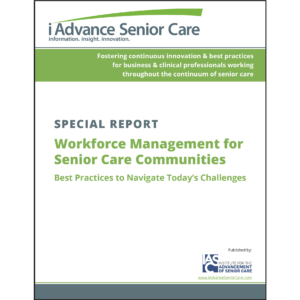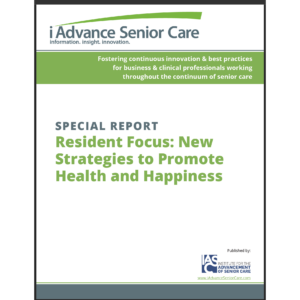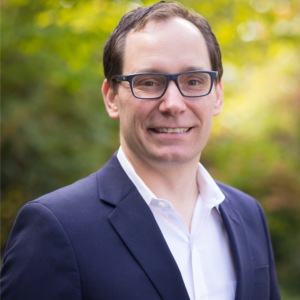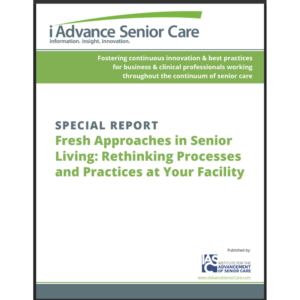Business as usual
Next month, a new president will be voted into office. With both Senators Barack Obama and John McCain espousing change, will the new occupant in the White House bring much-needed change in the long-term care industry? Long-Term Living asked a leading expert in aging, Robert Binstock, PhD, of Case Western Reserve University, Cleveland, Ohio, for his thoughts on what a new president might mean to the future of long-term care. Executive Editor Maureen Hrehocik spent an afternoon with Dr. Binstock talking about the prospects for long-term care.
Hrehocik: What are the prospects for long-term care in this election year?
Dr. Binstock: I don’t see many prospects for long-term care being a serious issue in this election. There’s no indication from either candidate at this point that they have any interest in the issue of long-term care. There are so many other issues that seem very pressing to the American public in general, such as how to deal with the operation in Iraq, the economy, jobs, and even in the so-called “value issues.” That, in itself, tells me that long-term care won’t be a serious issue. Even taking a longer term perspective, it hasn’t been a serious issue on the public policy agenda since it was part of President Clinton’s healthcare reform proposal. Of course, long-term care is on the public agenda with respect to federal and state concerns about the growing cost of Medicaid. In that sense, it’s on the agenda in a very negative fashion.
Hrehocik: Have the elderly become a political force?
Dr. Binstock: The elderly, as voters, haven’t really been a political force at all. Older people distribute their votes among candidates at about the same proportions as all age groups, except for the very youngest age group which doesn’t have its partisan attachments yet. “The elderly” is a very heterogeneous group of people; by social class, economic status, race, and priorities they give various issues. The elderly are not a political movement. AARP has gotten far more active in recent years as a “representative” of the elderly. But it’s not particularly pushing anything in a major way regarding long-term care. It’s only talking in generalities about healthcare reform. It’s just saying this is something that needs to be done. It’s very vague. No one has a good handle on it.
Hrehocik: Does anyone or any group have a handle on it?
Dr. Binstock: There are a number of organizations that care about these issues, but they don’t have substantial power. I think the greatest potential for a strong political movement lies with the families of those who need care—relatives who are providing care, and who have loved ones in residential facilities. I can see them becoming a real political force because they have a lot more in common than the elderly do. Of course, what they have in common is the relative’s need for long-term care and, in the case of caregivers, the physical, psychological, social, and economic burdens of providing care. It’s been striking to me when I give various talks around the country, how much the issue of long-term care really resonates among lay audiences. I spoke at the National Health Policy Forum early this summer in Washington. This was a panel with three of us giving presentations about all sorts of things regarding the elderly. We had an extensive discussion at the end of the session and it turned out that everyone in the audience wanted to talk about the issues of caregiving and long-term care. The moderator kept trying to get them to move along to other issues and she couldn’t do it! The audience was people who worked for various agencies in the federal government, Census Bureau, CMS, Capitol Hill staffers, all of whom had interest in the other topics we talked about, but what they wanted to talk about most was long-term care. So it seems to me, that’s where the potential to improve all sorts of things relating to long-term care lies. The growing potential is also exemplified with more and more media attention to these issues. Recently, the New York Times had a front-page story that was all about respite care. It was very well done and extensive and thoughtful. It concerned how caregivers should really become more aware of respite care and what it could do for them. It indicated more and more nursing homes that don’t have respite care beds, are recognizing that they might very well designate some of their beds for that purpose, which I thought was an interesting development. I think the media are paying more and more attention to these issues and writing them up very well.
Hrehocik: Is there any movement in the direction of families becoming the political force championing long-term care?
Dr. Binstock: Not of significance that I’m aware of. It’s certainly something that’s reasonable to do, in my opinion, considering how Alzheimer’s became a movement led by just a handful of people. A man in Chicago named Lester Stone whose wife had Alzheimer’s said we ought to do something about this to other people. This “word of mouth” gradually expanded and a group of lay people turned Alzheimer’s from being described as senility into being a disease in public perception. They “medicalized” the condition. They’ve been able to be very effective in getting federal funds for research on Alzheimer’s. If you think about it, Washington is populated with what are generally called voluntary health agencies and many of them have very large public policy operations, including the Alzheimer’s Association. Think about the American Cancer Society, the American Heart Association. There are tons of these associations. There’s a National Alliance for Caregiving, but I don’t think it’s become much of a strong national political force. The article in the New York Times said there were 9 million caregivers of persons with Alzheimer’s. How accurate that is I don’t know, but Alzheimer’s transcends state lines, class, and income. Sure, the rich can get more help with care, but still it’s not an easy situation to be in, both emotionally and otherwise. Anybody who’s been through it in one way or another certainly has a bond with someone else who’s been through it. Our resources on this are really limited. The costs alone of long-term care ought to unite people for action. The annual average cost of long-term care is getting close to $80,000 per year. New York City has the highest average-about $116,000. I just want to make a point here concerning cost. A lot of people feel that home care is cheaper, but if the person needing the care is appropriate in terms of their functionality for institutionalization, the cost at home is just as great or greater, much to the chagrin of people who keep asserting otherwise. Studies that have been done show this over and over again. My own experience with my mother, with nursing home care and home care, bears that out. It was slightly more expensive at home.
Hrehocik: With so many associations and so much interest in the problem, why hasn’t anything begun at a grassroots level to fix the problem? It certainly doesn’t seem like there’s a lack of interest.
Dr. Binstock: It would take some leadership to ignite some interest and to help people see what their common interests are rather than saying, “Oh, yeah, I know someone else who’s going through this.” They’re not seeing this as something that can be dealt with through public policy. You need a Ralph Nader or Lester Stone who founded the Alzheimer’s Association. Look at T. Boone Pickens. He’s got everyone thinking wind turbines. So, I don’t know who it is who could lead the long-term care charge. It’ll need to be someone with a lot of resources.
Hrehocik: Have you gleaned anything from presidential hopefuls Barack Obama and John McCain on their thinking toward long-term care policy?
Dr. Binstock: I pay a lot of attention, and I haven’t seen anything in their debates or speeches.
Hrehocik: What will it take for substantive change in the long-term care industry?
Dr. Binstock: One thing that would be helpful in the way of long-term care reform would be for the federal government to follow the example of some states, such as Ohio, in allowing premiums for long-term care insurance to be deductible from income tax. At present, the only way you can get a federal deduction for long-term care insurance expenses is to bundle them into medical expenses. Generally, you can start deducting when they exceed 7.5% of your gross income. If you have any sort of healthcare insurance, it is virtually impossible for your healthcare expenses to exceed 7.5% of your gross income. Being able to deduct it would be helpful for persons who need long-term care, their families, and for the organizations that provide long-term care as well as for the insurance industry. Certainly, the question of whether the government should have any new program to pay for long-term care beyond Medicaid is a tricky political question. Many advocates in the field of aging have heard this for years. Clinton certainly had this in his healthcare reform bill on a sliding scale if I remember correctly. But the question is, who pays for this, and it would be fair if someone said, “Why should I be taxed to pay for the long-term care of someone? Why don’t they use their own resources and when they exhaust those, there’s a safety net program called Medicare.” So what’s the function of the government paying for long-term care for people who could pay out of their assets and income? Some might say to preserve an inheritance for their children. That doesn’t make sense. On the other hand, if you made the taxes part of the social insurance system, say added it into your payroll tax, then you’d be sharing the risk widely, just as we do in terms of retirement income in old age and for Medicare Part A. There are countries that have done this. I think the first one was Germany which has long-term care available as a benefit under its social insurance program. It’s funded through part of the payroll tax. Frankly, I think that might be the ideal policy—spread the risk on something that can affect anyone. That would be politically palatable if we weren’t in the present environment of the national debt being so high and going higher and higher and the economy going so badly. I think that’s the most viable and sensible approach for the future.
Hrehocik: How do you feel about long-term care insurance?
Dr. Binstock: If one is careful in choosing stable, reliable companies, which is a very important part of it, it can fit the needs of some families better than others. I purchased it to provide income protection for my wife. I think that’s a good reason to do it. If you are hung up on providing an inheritance to your children, that’s another reason to do it. If you are hung up on not ever becoming a ward of the state by not going on Medicaid, that’s another reason to do it. If you’re very wealthy, there’s no need to purchase it. It depends on the circumstances and goals of the individual. I know that many of my colleagues in the field of aging say, “Oh, that’s a silly thing to purchase.” They say it doesn’t make economic sense. But it actually depends on your personal situation and goals.
Hrehocik: Is Social Security collapsing?
Dr. Binstock: The Trustees of the Social Security system project it will not “collapse” over the next 75 years. Their latest report in 2008 projected that Social Security would reach a point in 2041 where it could only pay 78% of the benefit. So, the notion that Social Security is going to go flat broke is wrong, and in fact, in each of the last few years, the percentage that Social Security will be able to pay, has increased. It used to be about 70% then it rose to 75%, then it rose to 78% and that’s, of course, if public policy stays the same. What we know about public policy is that it changes all the time. So, it will probably pay 100% in 2041.
Hrehocik: What could be done to make up that shortfall?
Dr. Binstock: There are lots of things that could be done rather easily. The trustees of Social Security in their report say if you added .85 of 1% to the employer and the employee payroll taxes that would solve the problem completely for a 75-year period. In my view, you don’t even have to do that. You could do a number of things together. You could make that a much smaller tax increase. You could, for example, put in a miniscule increase, say .01 of a percent, and gradually increase it over the years and it would be perfectly viable politically. Of course, you have to go higher than .85 because you started out so slowly. There are other things that could be done. For example, you could do away with the cap on the Social Security portion of the payroll tax which has people earning above $102,000 paying no payroll taxes on the rest of their earnings for the year. If you eliminated that cap completely, you’ve basically solved the problem. Obama is actually saying that he would have people earning over $250,000 keep paying the tax. In other words, he has a doughnut hole between the $102,000 and the $250,000 where you don’t pay. Well, that’s sort of silly. It would help, but if you just eliminated the cap, you would be doing the same as has been done with Medicare since 1993. In other words, since 1993, people of any income pay their Medicare tax all year. So, that was done without any big political uproar. We’ve lived with that for 15 years. I think that’s politically viable. But suppose you didn’t go all the way up on that; suppose you have a doughnut hole like Obama’s and lifted the cap just a little higher. You could do many things. You could levy a small tax increase on the payroll tax; you could do something with the cap on how much income you earned; you could slightly reduce benefits, but you wouldn’t call it that. Only economists would say that. You could do that by raising the age of eligibility for Social Security benefits—higher than age 67 that it’s projected to be in 2027. In fact, you could follow the model of the legislation that instituted the age of 67, which was passed in 1983. It raised the “full retirement age” from 65 to 67 starting in 2003, to be gradually implemented so it will not reach age 67 until the year 2027 legislation. The early part of it actually has had quite a jump and is now well over age 66. But the rest of it is going to be very slow. You could accelerate it to keep in step with the average life expectancy and get it up to 70, for example. So that would help and there is a lot of lead time. It’s not until 2041 when there will be a shortfall, not a collapse. And then there’s some who say you can even dedicate part of the payroll tax and the estate tax for Social Security. So, personally, I and my co-author Jim Schulz (Aging Nation: The Economics and Politics of Growing Older in America, Baltimore, Md., Johns Hopkins University Press, 2006) favor doing a little bit of each of these things which is pretty much what the 1983 amendments to Social Security did when there was a problem of shortfall anticipated there. There was a little bit of castor oil spread around.
Hrehocik: And with respect to Medicare?
Dr. Binstock: With respect to Medicare, the problem is much tougher because Medicare isn’t the problem. It’s the overall healthcare system. Numerous studies have shown that population aging does not account for much of our increase in healthcare costs. Most health economists would put aging at no more than 10% of the problem. So the real cost increases, which then go over to the Medicare system, are the introduction of new technologies and procedures that are high cost. And they’re endless. Think of the example of noninvasive imaging. For years we had the X-ray. We added the MRI, the PET scan, and the CAT scan. We didn’t stop using the X-ray. Medicare gets confronted with the recovery costs. So there are lots of things covered in recent years that are very expensive. You also have direct-to-consumer advertising. And if Medicare covers something, how can your private insurer say they don’t cover it because it’s an experimental procedure? So, in a sense, Medicare decisions do affect a lot of our healthcare system, so a lot of the cost containment Medicare did also helped out in the private sector, too.
So, it’s not about Medicare, it’s about healthcare in general. So what about healthcare? I talk to many healthcare economists. The best of them say there are things that we might do with the marginal impacts, but basically, the best one I know says he thinks we’re going to have a meltdown in the system. Meaning it will get to the point where hospitals refuse to participate in certain programs. I’m not as gloomy as that. My own approach would be to put everybody on Medicare. One of the terrific gains from that would be in the area of administrative costs. Medicare administrative costs are about 3% and in the private sector they’re over 20%. Administrative costs include marketing, claim denials, and so forth, so that would save a lot right there. Medicare has been a very successful program. The only problem is one of the most powerful entities in the country would be against Medicare for all, and that, of course, would be the insurance industry. The healthcare insurance industry would go out of business.
Hrehocik: Other than having Medicare take over, are there any other means to improving the system?
Dr. Binstock: Yes, there are lots of documented regional variations on how many procedures are done and costs of things. There’s a group at Dartmouth that documents all of these things. If we could begin to get down to closing the gap downward on some of these regional and institutional differences, that would help. Healthcare costs are really a big problem and I don’t have any easy answers, other than ideally we should go to a single-payer system like Medicare.
Hrehocik: What is needed to improve the healthcare system in the United States?
Dr. Binstock: If I had a good answer to that one, I would demand that I would immediately be appointed Secretary of Health and Human Services. A key challenge to states is to educate their state legislators and governors regarding the importance of keeping up Medicaid payments at a level at which quality long-term care can be provided. This will be an ongoing challenge in the years ahead, especially in states like Ohio that have term limits. Because the students that need to be educated will change very frequently.
Hrehocik: And the “students” are the legislators?
Dr. Binstock: Exactly.
Robert H. Binstock, PhD, is Professor of Aging, Health, and Society at Case Western Reserve University, Cleveland, Ohio, and a member of the Long-Term Living Editorial Advisory Board. A former president of the Gerontological Society of America, and recipient of numerous awards, he has served as director of a White House Task Force on Older Americans and as chairman and member of many advisory panels to federal, state, and local governments.
To send your comments to Dr. Binstock and the editors, e-mail binstock1008@iadvanceseniorcare.com.
Sidebar
Robert H. Binstock, PhD, on:
LTC reform:
“One thing that would be helpful in the way of long-term care reform would be for the federal government to follow the example of some states, such as Ohio, in allowing premiums for long-term care insurance to be deductible from income tax.”
Medicare:
“Medicare isn’t the problem. It’s the overall healthcare system.”
Social Security:
“The Trustees of the Social Security system project it will not ‘collapse’ over the next 75 years. Their latest report in 2008 projected that Social Security would reach a point in 2041 where it could only pay 78% of the benefit. So, the notion that Social Security is going to go flat broke is wrong, and in fact, in each of the last few years, the percentage that Social Security will be able to pay, has increased.”
Improving the U.S. healthcare system:
“A key challenge to states is to educate their state legislators and governors regarding the importance of keeping up Medicaid payments at a level at which quality long-term care can be provided.”
I Advance Senior Care is the industry-leading source for practical, in-depth, business-building, and resident care information for owners, executives, administrators, and directors of nursing at assisted living communities, skilled nursing facilities, post-acute facilities, and continuing care retirement communities. The I Advance Senior Care editorial team and industry experts provide market analysis, strategic direction, policy commentary, clinical best-practices, business management, and technology breakthroughs.
I Advance Senior Care is part of the Institute for the Advancement of Senior Care and published by Plain-English Health Care.
Related Articles
Topics: Articles











